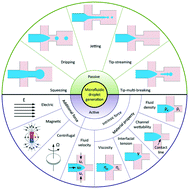Passive and active droplet generation with microfluidics: a review
Abstract
Precise and effective control of droplet generation is critical for applications of droplet microfluidics ranging from materials synthesis to lab-on-a-chip systems. Methods for droplet generation can be either passive or active, where the former generates droplets without external actuation, and the latter makes use of additional energy input in promoting interfacial instabilities for droplet generation. A unified physical understanding of both passive and active droplet generation is beneficial for effectively developing new techniques meeting various demands arising from applications. Our review of passive approaches focuses on the characteristics and mechanisms of breakup modes of droplet generation occurring in microfluidic cross-flow, co-flow, flow-focusing, and step emulsification configurations. The review of active approaches covers the state-of-the-art techniques employing either external forces from electrical, magnetic and centrifugal fields or methods of modifying intrinsic properties of flows or fluids such as velocity, viscosity, interfacial tension, channel wettability, and fluid density, with a focus on their implementations and actuation mechanisms. Also included in this review is the contrast among different approaches of either passive or active nature.

- This article is part of the themed collections: Lab on a Chip Recent Review Articles and Lab on a Chip 2017 Most Downloaded Articles


 Please wait while we load your content...
Please wait while we load your content...